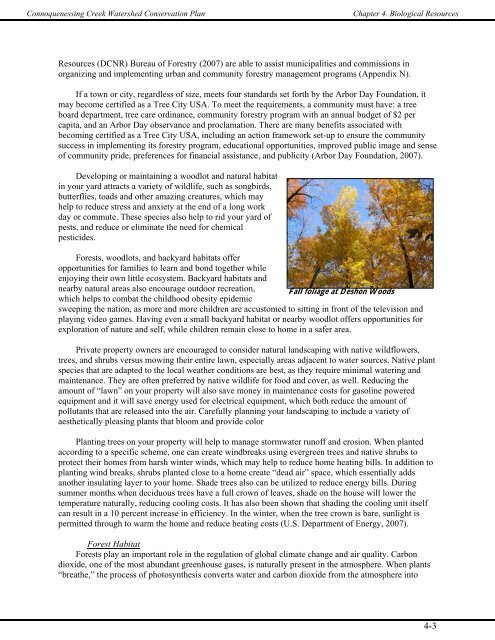CHAPTER 4 - Western Pennsylvania Conservancy
CHAPTER 4 - Western Pennsylvania Conservancy
CHAPTER 4 - Western Pennsylvania Conservancy
Create successful ePaper yourself
Turn your PDF publications into a flip-book with our unique Google optimized e-Paper software.
Connoquenessing Creek Watershed Conservation Plan<br />
Chapter 4. Biological Resources<br />
Resources (DCNR) Bureau of Forestry (2007) are able to assist municipalities and commissions in<br />
organizing and implementing urban and community forestry management programs (Appendix N).<br />
If a town or city, regardless of size, meets four standards set forth by the Arbor Day Foundation, it<br />
may become certified as a Tree City USA. To meet the requirements, a community must have: a tree<br />
board department, tree care ordinance, community forestry program with an annual budget of $2 per<br />
capita, and an Arbor Day observance and proclamation. There are many benefits associated with<br />
becoming certified as a Tree City USA, including an action framework set-up to ensure the community<br />
success in implementing its forestry program, educational opportunities, improved public image and sense<br />
of community pride, preferences for financial assistance, and publicity (Arbor Day Foundation, 2007).<br />
Developing or maintaining a woodlot and natural habitat<br />
in your yard attracts a variety of wildlife, such as songbirds,<br />
butterflies, toads and other amazing creatures, which may<br />
help to reduce stress and anxiety at the end of a long work<br />
day or commute. These species also help to rid your yard of<br />
pests, and reduce or eliminate the need for chemical<br />
pesticides.<br />
Forests, woodlots, and backyard habitats offer<br />
opportunities for families to learn and bond together while<br />
enjoying their own little ecosystem. Backyard habitats and<br />
nearby natural areas also encourage outdoor recreation, Fall foliage at Deshon Woods<br />
which helps to combat the childhood obesity epidemic<br />
sweeping the nation, as more and more children are accustomed to sitting in front of the television and<br />
playing video games. Having even a small backyard habitat or nearby woodlot offers opportunities for<br />
exploration of nature and self, while children remain close to home in a safer area.<br />
Private property owners are encouraged to consider natural landscaping with native wildflowers,<br />
trees, and shrubs versus mowing their entire lawn, especially areas adjacent to water sources. Native plant<br />
species that are adapted to the local weather conditions are best, as they require minimal watering and<br />
maintenance. They are often preferred by native wildlife for food and cover, as well. Reducing the<br />
amount of “lawn” on your property will also save money in maintenance costs for gasoline powered<br />
equipment and it will save energy used for electrical equipment, which both reduce the amount of<br />
pollutants that are released into the air. Carefully planning your landscaping to include a variety of<br />
aesthetically pleasing plants that bloom and provide color<br />
Planting trees on your property will help to manage stormwater runoff and erosion. When planted<br />
according to a specific scheme, one can create windbreaks using evergreen trees and native shrubs to<br />
protect their homes from harsh winter winds, which may help to reduce home heating bills. In addition to<br />
planting wind breaks, shrubs planted close to a home create “dead air” space, which essentially adds<br />
another insulating layer to your home. Shade trees also can be utilized to reduce energy bills. During<br />
summer months when deciduous trees have a full crown of leaves, shade on the house will lower the<br />
temperature naturally, reducing cooling costs. It has also been shown that shading the cooling unit itself<br />
can result in a 10 percent increase in efficiency. In the winter, when the tree crown is bare, sunlight is<br />
permitted through to warm the home and reduce heating costs (U.S. Department of Energy, 2007).<br />
Forest Habitat<br />
Forests play an important role in the regulation of global climate change and air quality. Carbon<br />
dioxide, one of the most abundant greenhouse gases, is naturally present in the atmosphere. When plants<br />
“breathe,” the process of photosynthesis converts water and carbon dioxide from the atmosphere into<br />
4-3














